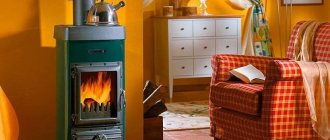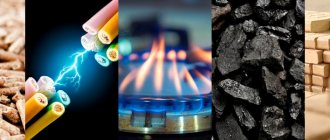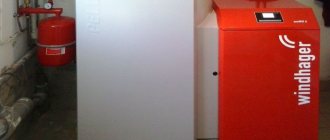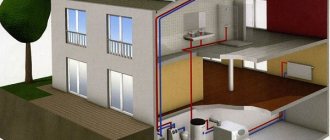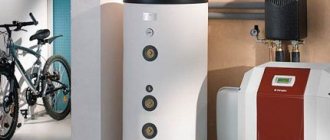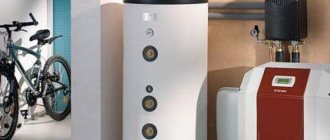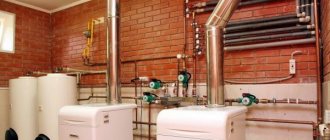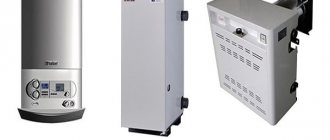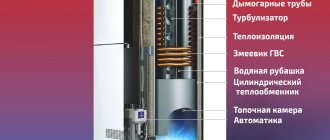When the cold weather sets in, it is extremely important to keep your home cozy, comfortable and warm. This needs to be taken care of in advance by organizing a high-quality heating system. The key issue in such a matter is always the choice of boiler.
The assortment of online and offline stores offers a huge number of options for the buyer to choose from: units operating on solid and liquid fuels, connected to the electrical network or gas mains, combined devices. From the point of view of experts, one of the most rational solutions would be a wood-burning boiler for heating a private home.
An indisputable advantage of solid fuel models is efficiency. This equipment is more difficult to maintain and is inferior in some respects to other types of heating devices. But if chosen correctly, it will be no less effective. What should you consider when purchasing and what models should you pay attention to? Next we will tell you about everything in detail.
Rating of solid fuel boilers
Manufacturers take into account customer requirements for modern technology. In addition to classic designs, the companies' catalogs now include long-burning solid fuel boilers, capable of operating for up to 36 hours on one load of coal. Pyrolysis boilers demonstrate excellent characteristics. We have studied the features and specific operation of equipment of all categories on the market. To be included in the rating, equipment had to meet strict safety requirements, have high efficiency, be functional and easy to maintain. Our team took into account user feedback, compared fuel consumption, and analyzed maintainability.
Experts paid special attention to the following characteristics:
- Recommended fuel – the combustion temperatures of wood and coal are different, this affects the choice of material for the chamber;
- Power – affects the frequency of bookmarks;
- Efficiency - the profitability of the heating system depends on this indicator;
- Volatility - automatic models are easy to use, but require increased attention to ensuring uninterrupted power supply;
- Safety – the use of thermal insulation reduces the risk of burns and ignition of building materials;
- Durability – the quality of steel and cast iron affects the service life.
Not all models met the stated characteristics and requirements of experts. Equipment with a low level of safety, high fuel consumption, and low-quality main components were excluded from our rating.
The best wood splitters
No. 4. Traction and energy consumption
Solid fuel boilers can be divided into two types:
- non-volatile with natural draft . They do without special pumps, so they do not consume electricity. Classic boilers and some long-burning boilers operate in a similar design. Well suited for areas where there are frequent power outages, can be used as a backup heat source;
- volatile with additional traction . The design includes a fan that helps air flow into the combustion chamber. Most long-term combustion boilers, pellet and pyrolysis boilers are produced in this design. Thanks to the control panel, you can make some settings.
The best long-burning solid fuel boilers
The duration of combustion on one load of fuel is one of the main selection criteria. The duration can be increased in two ways: by expanding the volume of the fuel chamber or implementing the principle of reverse combustion. The VyborExperta.ru project team analyzed 8 boilers and chose 3 models. The offered equipment is characterized by high profitability, maximum efficiency and safety.
Zota Topol-16VK
A boiler with one heating circuit with a power of 16 kW, designed for heating buildings with an area of 50 to 160 sq.m. Equipped with a built-in 29 liter boiler, designed for a maximum coolant temperature of 95 ºС. You can burn wood, coal or briquettes in the chamber. The maximum permissible pressure in the system is 3 atm.
The complex configuration of the heat exchanger and grates filled with coolant provide high efficiency. A water jacket coated with basalt cardboard helps reduce heat loss from the heat exchanger. Fuel can be loaded through a vertical or horizontal firebox. Access to the heat exchanger for cleaning is through a removable damper. The model can be equipped with a pellet burner and automated operation.
Advantages:
- Adjustable blower damper;
- The thermometer allows you to measure the temperature of the coolant;
- Improved heat transfer efficiency;
- Autonomous ash door;
- Burning time – 10-12 hours;
- Possibility of completing with heating element;
- Capacious firebox – 39 l;
- Low price.
Flaws:
- Firewood length up to 396 mm.
The model can be equipped with automation that controls combustion. The equipment regulates the air supply, maintaining optimal conditions. This allows you to increase the combustion duration on one fuel load by 70%.
Teplodar Cooper Expert-22
Floor-standing model with a power of 22 kW, intended for installation in private homes with an area of up to 220 sq.m. Works on fuel briquettes, coal and wood. Burning on one tab for up to 24 hours thanks to top combustion with three-zone air supply. The extended package includes a pre-installed heating element, a gate valve and an Italian-made thermometer to control the temperature of the coolant. All accessories for cleaning cameras are included. There are two hatches installed for cleaning.
The design allows you to install a pellet or gas burner and reconfigure the equipment in half an hour. Operates in four different modes that allow you to quickly raise the temperature in the system or ensure maximum profitability.
Advantages:
- Versatility;
- Fast heating;
- Convenient loading of fuel through the inclined door;
- A removable stainless steel tray additionally protects the firebox door from overheating;
- Manufacturer's warranty 3 years;
- Good heat dissipation.
Flaws:
- Firewood is only small in size;
- Requires regular cleaning.
NMK Magnum KDG 20 TE
The NMK company produces solid fuel boilers for homes that operate throughout the heating season without stopping for maintenance. Coal is recommended as fuel. A power of 20 kW allows you to cope with the heating of a country house with an area of 180-200 sq.m. The equipment is equipped with an automatic draft thermostat, which controls the air supply and coolant temperature. A pressure gauge on the front panel makes it easy to control operating pressure. The recommended water pressure in the circuit is no more than 2 atmospheres.
The design of the chambers and water jacket made it possible to increase the efficiency of the equipment to 80%. To maintain comfortable conditions in the off-season, you can install a heating element. Mechanical control makes the equipment completely energy independent.
Advantages:
- Low fuel consumption;
- Good level of thermal insulation;
- Works on any type of coal;
- Stylish design;
- Easy target setting of operating temperature.
Flaws:
- One type of fuel.
The best classic solid fuel boilers
The classic solid fuel cast iron boiler replaced the stove. The equipment has a simple design and operates on the principle of direct combustion - from bottom to top. The equipment is produced by different manufacturers: from artisanal enterprises to industry leaders. Having analyzed 9 brands, we suggest paying attention to 4 boilers with an original design, a high level of safety and good thermal insulation, which makes work more economical.
Lemax Forward-12.5
Classic single-circuit boiler with an efficiency of 75%. A power of 13 kW allows you to maintain comfort in a small house with an area of 120-130 sq.m. Firewood, coal, and anthracite can be used as fuel. Top loading made it possible to make the design as compact as possible. The body is reinforced with a channel, and 4 mm thick steel is used as the main material. To protect against corrosion, the metal is treated with inhibitors and a heat-resistant decorative coating.
The grate bars are made of gray cast iron, which is characterized by high thermal resistance. To control the temperature, a thermometer is built into the front panel. You can control the operation of the equipment using a mechanical regulator.
Advantages:
- Maximum operating time on one load is 12 hours;
- Reinforced heat exchanger;
- Non-volatility ensures complete autonomy;
- Simple connection system to an indirect heating boiler;
- Low price.
Flaws:
- Small fuel chamber size.
The boiler can be converted to use mains gas. To do this, just install a gas burner. This design feature makes the model the optimal choice for new buildings.
Bosch Solid 2000 B SFU 12
Single-circuit boiler with high efficiency, which reaches 84%. Firewood, coal, coke, wood or coal briquettes can be used as fuel. Fuel consumption 5.3 kg/hour. The primary heat exchanger is made of heat-resistant steel. It is possible to install equipment for mechanical adjustment of air supply. The ash pan door is equipped with an adjustable throttle, which simplifies the supply of primary air.
Recommended coolant temperature is 65-95 degrees. To control the main operating parameters, a thermometer and a pressure gauge are installed. Recommended water pressure in the heating circuit is 2 atmospheres.
Advantages:
- Easy maintenance;
- Vertical loading;
- Energy independence;
- Thermal insulation efficiency;
- Improved combustion chamber design.
Flaws:
- Overcharge.
Evan Warmos TT-18
Single-circuit heating boiler with power from 6 to 18 kW. The design of the grate system makes the equipment unpretentious to the fuel used. The chamber can burn wood and wood waste with a humidity of up to 70%. The spacious chamber allows you to use logs up to 55 cm long. The maximum burning time on one load is up to 15 hours when using high-quality coal.
The protective screen makes servicing safe. To control the main operating parameters, a combined thermomanometer is installed. The installation of a draft regulator is provided, which varies the power in the range from 30 to 100%. As a backup heat source, an electric heater with a temperature limiter and a thermostat is built into the boiler.
Advantages:
- Combined thermal insulation saves heat and protects against burns;
- The system for supplying heated air to the combustion zone increases the combustion duration;
- Reinforced design;
- The combustion chamber is made of heat-resistant steel;
- Easy installation.
Flaws:
- The afterburning system for pyrolysis gases becomes clogged.
Protherm Beaver 20 DLO
Single-circuit floor model, designed for heating a house with an area of 160-180 sq.m. Efficiency – 70.8% when working on coal. In this indicator it can compete with pyrolysis and gas boilers. Coal or wood is used as fuel. The coolant temperature varies from 30 to 85 degrees. The double-pass cast iron heat exchanger provides a high heating area and maximum heat transfer.
The control system consists of a draft regulator and a thermostatic regulator, the operation of which does not require electricity. Built-in thermometer and pressure gauge allow you to monitor basic operating parameters. The maximum permissible pressure in the system is 4 atmospheres. This allows you to heat a large building.
Advantages:
- Impeccable build quality;
- Quickly heats the coolant to the set temperature;
- Volumetric combustion chamber;
- Increased interval between cleanings;
- Easy maintenance.
Flaws:
- High price;
- Expensive spare parts.
No. 2. Varieties
With a similar general design, different types of solid fuel boilers have some design nuances. The entire existing range can be divided into the following types:
- classic or traditional boilers;
- pyrolysis , or gas-generating boilers;
- long burning boilers ;
- pellet boilers.
Classic solid fuel
Such boilers are very similar to conventional stoves . The heat here is obtained as a result of the flaming combustion of fuel . As a rule, wood or coal . Fuel is supplied through one door, and through the other, the boiler is cleaned of ash and other products of incomplete combustion. Traditional boilers can have either a cast iron or a steel heat exchanger and are usually used in systems with natural circulation.
Although the efficiency of this type of device is not the highest, they are valued for their reliability , because the boiler design contains a minimum of electronic elements that can fail. The only element of automation is a temperature controller , but it also works on a mechanical principle. Classic boilers are durable and rarely require repairs.
Pyrolysis
Pyrolysis (gas generator) boilers are somewhat more complex. Their design has two combustion chambers . Solid fuel (wood) is placed in the first; at high temperatures and oxygen deficiency, the process of pyrolysis with the release of pyrolysis gas. It goes into the second chamber, where it burns and gives off heat to the coolant. All that remains from the firewood is charcoal.
The combustion temperature of pyrolysis gas is higher than that of firewood, which ensures an increase in boiler efficiency of up to 90%. If we take into account the fact that the smoldering process of wood is slower than its combustion, then we can talk about another advantage - one load of fuel will last for 10-13 hours (for classic boilers this figure is 5-7 hours). Hardwood with low humidity (no more than 20%) is used as fuel.
Long burning
This type of boiler is in many ways similar to pyrolysis boilers, but differs in some technical features. Solid fuel smolders in the first chamber , forms gases that burn out in the second firebox . , only the upper part of the fuel is involved in the process of smoldering and combustion . Due to this, it has to be loaded less often, and efficiency increases. One load of firewood is enough to keep the boiler running for two days . The main disadvantage is the high cost of the equipment.
Pellet
They are often also called automatic boilers . According to the principle of operation, they are not much different from traditional ones, but in addition to the firebox, they have a bunker for storing fuel reserves. This means that it will be unnecessary to frequently go up and pour fuel into the firebox manually - everything will be done automatically. 7 days can pass between loading the fuel supply . In addition, such a system can be very precisely adjusted to suit you. The fuel is considered one of the most environmentally friendly at the moment. Pellets are granules that are produced from wood waste (sawdust, shavings, etc.). The efficiency of such systems is 91-95% , the only negative is the high price of the boilers .
The best pyrolysis solid fuel boilers
The original system of a solid fuel boiler of this type has a two-chamber design. In the first chamber, when there is a lack of air, the fuel burns, releasing pyrolysis gas. Pyrolysis gas burns in the second chamber; this process can be regulated, which saves fuel. Two-stage combustion allows the solid fuel to burn out completely, which increases efficiency. The equipment is more comfortable to use, but requires the use of dry firewood and depends on electricity. The VyborExpert.ru team analyzed 9 models and selected 3 pyrolysis boilers, which are highly efficient, reliable and do not require complex maintenance.
Vesuvius Elbrus-10
A simple and reliable design, designed for heating a small house or cottage with an area of up to 100 sq.m. It runs on wood and coal, it is possible to install a heating element with a power of 6 kW. The recommended pressure in the system is up to 3 atmospheres. The design of the heat exchanger simplifies access for cleaning. The efficiency reaches 80%, approaching the performance of diesel fuel boilers.
The body is made of structural steel, the sealed doors are made of cast iron. The thermostat, heating element and heating system can be connected from either side of the housing. The equipment is designed to work in systems with natural and forced circulation.
Advantages:
- Precise power control helps create a comfortable microclimate;
- Effective basalt thermal insulation;
- Compact design;
- One stack of wood burns for 8 hours;
- Easy maintenance.
Flaws:
- Small volume of the chamber, which is designed for firewood 38 cm.
The model has a simple design, which allows you to do without installing a smoke exhauster powered by electricity. A non-volatile pyrolysis boiler is an economical solution for a country house and cottage in a village remote from civilization.
Burzhuy-K Standard-20
High power and efficiency of 85% allow the equipment to be used for the heating system of a house with an area of 200-220 sq.m. The heat exchanger is made of heat-resistant steel. The volumetric chamber allows the use of firewood up to 55 cm long. Works on all types of solid fuel. The maximum coolant temperature is 95 degrees, the pressure in the system can reach 4.5 atmospheres.
The model is equipped with a thermostat, a pipe for connecting a chimney with a damper. Mechanical control makes the system energy independent. Built-in thermometer and pressure gauge make it easy to control key operating parameters.
Advantages:
- Burning time on one stack of firewood is up to 12 hours;
- Low percentage of harmful emissions into the atmosphere;
- Maximum fuel burn;
- High rate of room heating;
- Manufacturer's warranty 30 months.
Flaws:
- There is no provision for connecting a heating element.
Atmos DC 32S
A powerful model designed to heat a building with an area of 250-350 sq.m. When creating, heat-resistant steel with a thickness of 3 to 8 mm is used. To increase heat transfer, ceramic blocks are used in the chamber. The power is automatically adjusted using an electromechanical damper. The regulator performs the function of overheating protection. The control thermostat controls the fan, which blows air and maintains the set temperature. It can work with the fan turned off, but the power drops to 70%.
The model can be equipped with a proprietary electronic control system that takes into account the air temperature indoors and outdoors. The microcontroller controls fans and other equipment, allowing you to save fuel and increase the burning time on one tab.
Advantages:
- Efficiency up to 90%;
- Spacious camera;
- Maximum log length 53 cm;
- Dust-free ash collection;
- The cooling circuit protects against overheating;
- Automatic shutdown when fuel burns out.
Flaws:
- High price.
No. 1. About operating principles
It would seem that what’s so complicated about a solid fuel boiler? I threw wood or coal into the firebox, they burned, heated the water, and the house was filled with warmth. In general, everything is true, but the principle of operation of the device is somewhat more complicated. The following basic elements can be distinguished in the design of a modern solid fuel boiler:
- firebox;
- coolant circulation system;
- smoke removal system;
- safety system;
- heat storage system.
Fuel is supplied to the furnace and burned to produce heat. This is the classic version. There are pyrolysis boilers in which solid fuel (wood) smolders, releasing gas, which then burns, providing heat. In this case, the efficiency increases somewhat, but we will deal with the operating features of classical and pyrolysis boilers later.
The firebox is a large container with double walls , between which there is a coolant . In most cases this is water, less often an antifreeze liquid or a mixture of water and antifreeze is used. The coolant receives heat from burned fuel, circulates through pipes and radiators, heating the air in the house. Cooling down, the water returns to the boiler and everything repeats. Often, special pumps are used to improve circulation.
When burning fuel, not only heat is generated, but also gases that must be removed. A smoke removal system is designed for this purpose . The chimney removes gases from the boiler to the street; sometimes a forced ventilation system .
The biggest danger that can happen when operating a solid fuel boiler is overheating of the coolant . The water may already be sufficiently heated, and the boiler will continue to produce heat. If the water boils, the heating system may not be able to handle it, especially if the house has metal-plastic pipes that are quite sensitive to high temperatures. It is almost impossible to stop the combustion of wood or coal - all that remains is to reduce the intensity, and to prevent overheated coolant from entering the system, use a cooling heat exchanger . It receives cold water from the water supply, but in case of a water outage it is better to always have a sufficient supply.
The cooling heat exchanger can be built into the boiler or located between the boiler and the rest of the heating system. It can only be built into the structure of a steel boiler. It works in one of two possible ways:
- The first option is cooling the heated coolant , which passes through a cooling heat exchanger. Cold water is supplied to the cooling heat exchanger through a thermal valve, which opens when the coolant temperature reaches +950C. The process continues until the coolant cools to a safe temperature;
- the second option provides presence of shut-off valve.
If the water temperature rises to critical values, the valve does not allow it to enter the pipes. Cold water is supplied to the heating system from the water supply system, and the overheated coolant is drained into the sewer. True, the water pressure should be sufficient, and its composition should not contain an increased amount of salts, which will provoke the formation of scale.
Draining heated water into the sewer is not very smart and economical, so it is better to supplement the design of a solid fuel boiler with a storage tank . This is a buffer between the boiler and the rest of the heating system, thanks to which a number of important functions :
- accumulation of warm water for its further use, and this means fuel economy, comfort, stability in maintaining temperature and reducing the number of trips to the firebox to add fuel;
- accident protection . In the tank, superheated water is mixed with warm water;
- possibility to use different types of boilers . The storage tank will be common to a solid fuel boiler and, for example, a gas or electric boiler; it will allow you to simply organize a unified heating system for your home and secure yourself with several heat sources.
Thermal accumulators are made of cast iron or steel and receive powerful thermal insulation . The volume of the buffer , first of all, depends on the power of the boiler : for every 1 kW it is necessary to provide 25 liters of tank volume . The quality of this element of the heating system must be of the highest quality, so it is better to trust products from well-known manufacturers. The online store https://www.duim24.ru/ presents heat accumulators only from trusted companies; the range includes tanks of different volumes and materials of manufacture.
How to choose a solid fuel boiler
Heating equipment must be reliable, economical, and capable of maintaining an optimal microclimate. Equipment that meets these requirements is offered by domestic and foreign companies. Which solid fuel boiler is better for a private home, and which can only cope with heating a small cottage, depends on a number of parameters taken into account when choosing a model.
Thermal power
You can buy a small, inexpensive boiler, but you need to take into account the power of the equipment. Manufacturers must indicate this characteristic in the technical documentation. The maximum area of the heated room depends on the thermal power. These parameters are directly related: per 1 kW there should not be more than 10 sq.m. premises with a ceiling height of 2.7 meters. For heating a small house of 60-70 sq.m. A boiler with a thermal power of 6-7 kW is sufficient.
Preliminary calculations are relevant for small buildings. More precise parameters should take into account the calorie content of the fuel used, the number of radiators installed, the presence of a boiler and its volume. It is recommended to order a detailed calculation of thermal power from heating engineers. This will help get rid of problems during severe frosts or when using low-calorie fuel.
Efficiency
The ratio of consumed fuel to the amount of useful heat is called efficiency. There is no equipment with 100% indicators; heat loss occurs from underburning of the emitted gases, which corresponds to the appearance of soot. Part of the thermal energy goes through the pipe, the other is spent on heating the walls and heat exchange with the air of the room where the equipment is installed. Efficiency is reduced by raw fuel and improper air supply.
The maximum efficiency is found in pyrolysis-type models; it can be made higher not only by the high combustion temperature of the gases, but also by the complete combustion of the fuel. Manufacturers increase efficiency by installing combined thermal insulation, of which the water jacket becomes part - energy is spent not on heating the air, but on increasing the temperature of the water. The higher the efficiency, the more cost-effective the heating system.
Type of fuel
It is recommended to buy a boiler that runs on an available type of fuel. Automated pellet models are attractive due to their functionality, but if you don’t have access to pellets, you can end up in a cold house. Universal models operate on coal and wood. Coal burns longer, allowing you to spend a minimum of time on maintenance. Firewood is a more affordable type of fuel.
When choosing a wood-burning model, you should take into account the recommended log size and the ability to efficiently burn raw fuel. Pyrolysis boilers operate on dry wood. If it is not possible to store fuel in a room with normal humidity, then such equipment will have to be abandoned.
Heat exchanger material
Manufacturers produce models with steel and cast iron heat exchangers. Heat exchangers made of heat-resistant steel have low inertia, are easy to maintain, light in weight and resistant to mechanical damage. Steel can be used to make structures of any complexity and improve operating parameters. Disadvantages: short service life, risk of burnout and low corrosion resistance.
Cast iron sectional heat exchangers are resistant to corrosion, acids, and high temperatures. Good heat transfer allows the use of small sections. Cast iron is a brittle material that is not resistant to sudden temperature changes. Heat exchangers are heavy and have low efficiency.
Number of heating circuits
Models with one water circuit are intended for heating only. A double-circuit boiler will provide heat and hot water. These models are more expensive, so if necessary, it is better to use equipment with the ability to connect a boiler. Heating in the summer is not always comfortable; in this situation, a solid fuel electric boiler with a heating element will help out, which will maintain the desired temperature in the hot water supply system.
Rules for choosing a heating boiler
Before you start choosing a specific heating boiler model, you need to study the criteria that you should focus on. By understanding the operating features and basic parameters of the equipment, you can choose a device that can satisfy all your needs.
First of all, consider these nuances:
- boiler type and efficiency;
- camera design;
- device power and room area;
- combustion time and supported fuel types;
- heat exchanger material;
- additional functions and protection systems.
Boilers are single-circuit and double-circuit . The first option is connected to an autonomous heating system and is intended exclusively for heating. Some models work in conjunction with a boiler.
The second option replaces the water heater and boiler, providing not only heating, but also hot water supply.
The boiler efficiency indicator, expressed in the efficiency parameter, shows how productive the device is. The higher it is, the less volume of fuel materials will be needed to heat the room
One of the main indicators of equipment is the output thermal power. This parameter must be selected based on the area that is supposed to be heated.
It is highly desirable that the model has the ability to adjust the power, allowing you to achieve the optimal comfortable temperature.
Boilers with an open chamber design take oxygen from the room and remove combustion products through the chimney. They should be installed in areas with good ventilation. Units with a closed chamber type can be placed in almost any room
The frequency of loading depends on the combustion time of the fuel in the boiler. Pyrolysis boilers and long-burning appliances retain heat the longest. The best option would be units that run not only on wood, but also on alternative fuels.
Also, when choosing, it is important to pay special attention to the heat exchanger:
Image gallery
Photo from
Heat exchanger in a heating boiler
Solid fuel boiler with steel heat exchanger
Cast iron model of heating boiler heat exchanger
Boiler with copper heat exchanger
Operational safety and equipment efficiency are enhanced by additional built-in mechanisms and functions. It’s good if the selected model has overheating protection, devices for regulating traction, measuring current pressure and temperature.
Which solid fuel boiler is better
Replacing heating equipment during the height of the winter season can lead to serious problems. To prevent this from happening, you need to be careful when buying a boiler. The equipment must run on accessible fuel, have simple and reliable functionality, and high efficiency. In this case, the property owner will be able to significantly reduce heating costs.
Our experts have analyzed the products of the best manufacturers and, depending on the specifics of use, recommend the following models:
- Zota Topol-16VK - a simple and economical model for a private home;
- Lemax Forward-12.5 - reliable equipment for the garden;
- Protherm Beaver 20 DLO - an efficient boiler for a country house;
- Vesuvius Elbrus-10 - compact equipment for a summer residence;
- Atmos DC 32 S is an economical boiler with a high degree of automation for a luxury mansion.
What kind of boiler should be capable of maintaining coziness and comfort in the house every day throughout the winter? Only the best models with easy maintenance and high energy efficiency can cope with this task.
